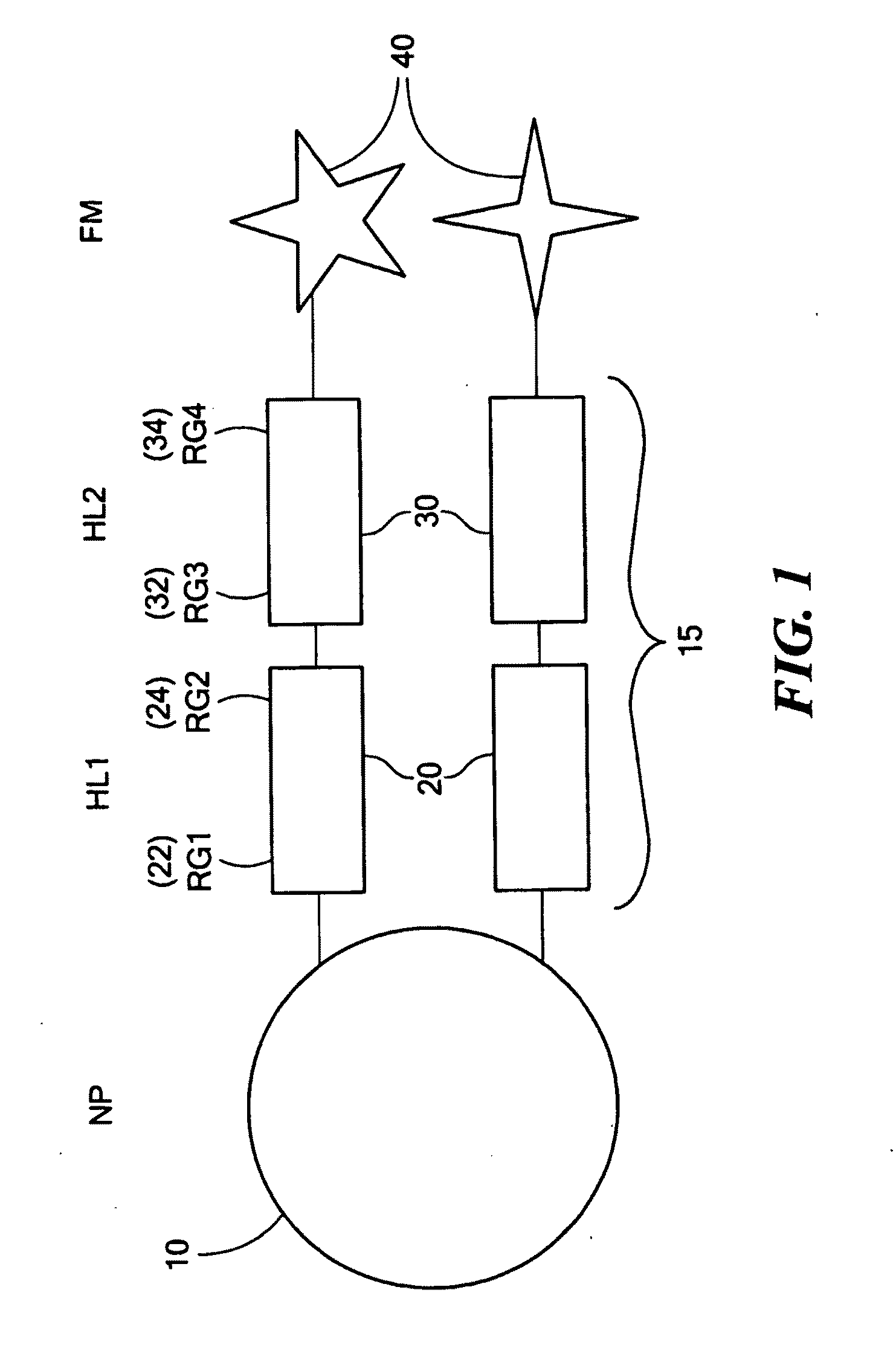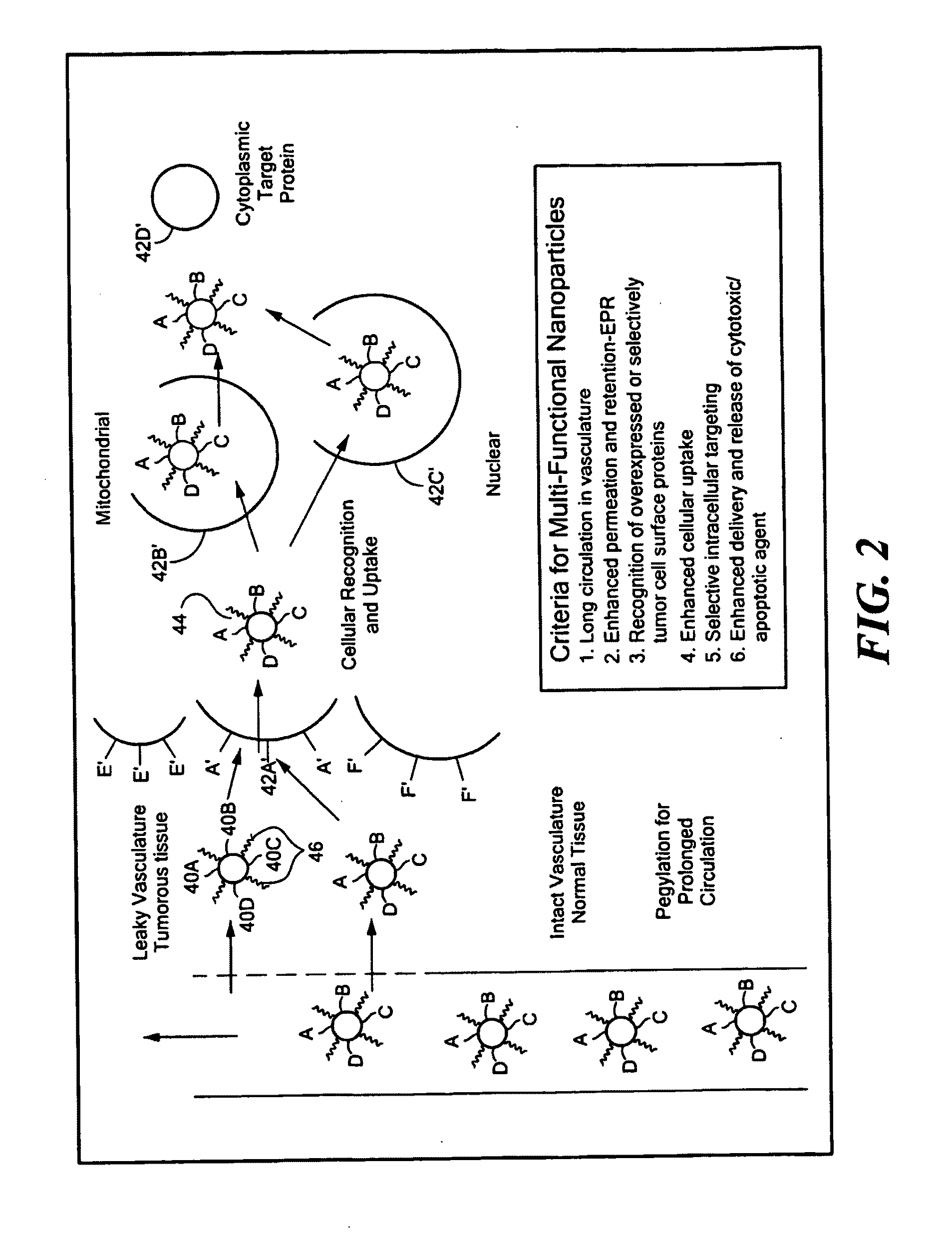Precision-guided nanoparticle systems for drug delivery
a nanoparticle system and precision-guided technology, applied in the field of nanoparticles to deliver diagnostic and therapeutic agents, can solve the problems of variability in ligation efficiency, difficult to introduce multiple functional units onto the surface of nanoparticles in reproducible ratios, and the control of the surface composition of nanoparticles, etc., to achieve the effect of diagnosing and treating diseas
- Summary
- Abstract
- Description
- Claims
- Application Information
AI Technical Summary
Benefits of technology
Problems solved by technology
Method used
Image
Examples
example 1
Preparation of First Half-Linkers
[0053]Two series of terminally functionalized thiolated units were prepared for use as first half-linkers. In each series lipoic acid was used as the dithiolated component (dithiol group serving as the first reactive group). In the first series, lipoic acid was attached to commercially available α-amino-ω-azido oligoethylene glycols (n=3, 5, 7, 9) using standard peptide coupling methods (N-hydroxysuccinimide, dicyclohexylcarbodiimide, DMF) in isolated yields of 60-85%. Increasing the ethylene glycol content created more polar, hydrophilic compounds. In the second series, an oligoethylene glycol was sequentially alkylated with propargyl or allyl bromide, converted to terminal amino derivative (Mitsunobu reaction with phthalimide followed by hydrazinolysis) and coupled to lipoic acid as described above. The resulting compounds provided first half-linkers of variable length and having various second reactive groups.
example 2
Ligation of Ethynylated Functional Moieties to First Half-Linkers
[0054]Several commercially available ethynylated steroid compounds, including 17α-ethynyl testosterone, 17α-ethynyl-nontestosterone and 17α-ethynyl estradiol, were selected as effector compounds to demonstrate the ligation methods. Ethynylated derivatives of fluorescein and 4-amino-TEMPO were also prepared for use as imaging agents. An ethynylated derivative of the 4-anilinoquinazoline EGFR tyrosine kinase inhibitor Tarceva® (erlotinib, which is N-(3-ethynylphenyl)-6,7-bis(2-methoxyethoxy)quinazolin-4-amine) was also prepared. In addition, an azido-oligoethylene glycolated-11β-substituted (antiestrogenic) steroid was prepared. The syntheses of the tyrosine kinase inhibitor and the anti-estrogen were based on a computational analysis of the crystal structures of inhibitors / ligands with their target proteins. Ligation of several lipoamido-azido derivatives (first half-linker) with ethynylated functional moieties (fluores...
example 3
Coupling of a First Half-Linker to Nanoparticles
[0055]Careful reduction of gold nanoparticles with borohydride in the presence of lipoic acid yielded dithiolated gold nanoparticles with diameters ranging from 15-25 nm. Initial preparation of nanoparticles using a dithiolated azido-oligoethylene glycol first half-linker (see above) also yielded materials with comparable dimensions. The nanoparticles were characterized using TEM and SEM to determine the particle diameter.
PUM
| Property | Measurement | Unit |
|---|---|---|
| Fraction | aaaaa | aaaaa |
| Diameter | aaaaa | aaaaa |
| Diameter | aaaaa | aaaaa |
Abstract
Description
Claims
Application Information
 Login to View More
Login to View More - R&D
- Intellectual Property
- Life Sciences
- Materials
- Tech Scout
- Unparalleled Data Quality
- Higher Quality Content
- 60% Fewer Hallucinations
Browse by: Latest US Patents, China's latest patents, Technical Efficacy Thesaurus, Application Domain, Technology Topic, Popular Technical Reports.
© 2025 PatSnap. All rights reserved.Legal|Privacy policy|Modern Slavery Act Transparency Statement|Sitemap|About US| Contact US: help@patsnap.com



